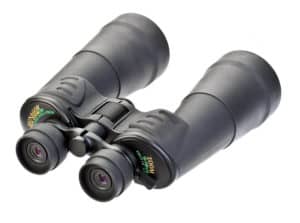The Science
The refraction of light is key to how binoculars work because it explains how lenses work. Refraction is The way light bends when it goes from the air to a different material. Placing a stick in water is a refraction of light because the stick appears bent, however it is not. A lens is a curved piece of glass and when light rays hit a piece of glass such as a lens, they slow down and bend. If the lens curves, so its outside is thinner than its middle, it’s called a convex lens. As light rays enter a convex lens, they  bend in toward the middle—as though the lens is sucking them in. That means a convex lens brings distant light rays into a focus. It’s also called a converging lens because it makes light rays come together (converge). Looking at things through a convex lenses makes them appear bigger—so convex lenses are used in things like magnifying glasses.
bend in toward the middle—as though the lens is sucking them in. That means a convex lens brings distant light rays into a focus. It’s also called a converging lens because it makes light rays come together (converge). Looking at things through a convex lenses makes them appear bigger—so convex lenses are used in things like magnifying glasses.
A different kind of lens curves the opposite way, with the middle being thinner than the outside is. This is called a concave lens. (You can remember this easily if you think that a concave lens caves in in the middle.) A concave lens makes light rays spread out like the lines of a firework. Imagine light rays coming into a concave lens and then shooting out in all directions. That’s why a concave lens is sometimes called a diverging lens. It makes light rays shoot out (diverge). Concave lenses are used in movie projectors to make light from the film spread out and cover a bigger area when it hits the wall.
But, Binoculars?
Okay, so hopefully you can see where we’re heading. If you want to see something in the distance, you can use two convex lenses, placed one in front of the other. The first lens catches light rays from the distant object and makes a focused image a short distance behind the lens. This lens is called the objective, because it’s nearest to the object you’re looking at. The second lens picks up that image and magnifies it, just like a magnifying glass magnifies an image on paper. If you put the two lenses in a closed tube, hey presto, you have a telescope. You can make your own telescope easily enough with a couple of magnifying glasses and a cardboard tube wrapped around them.
Binoculars are basically just two telescopes in one device, but when light rays pass through a convex lens from a distance they cross over. Hence why far away things often look upside down when looking at them through a magnifying glass.
So binoculars have a pair of prisms (big wedges of glass) inside them to rotate the image through 180 degrees. One prism rotates the image through 90 degrees (flips it onto its side), then the next prism rotates it through another 90 degrees (flips it onto its side again), so the two prisms effectively turn it upside down. The prisms can either be arranged in a back-to-back arrangement (known as roof prisms) or at 90 degrees (known as Porro prisms)
The prisms explain why binoculars are heavy and why they are sometimes quite chunky in the middle. Field glasses, which are compact binoculars like the ones shown in the photo here, flip the incoming images using only lenses. There are no prisms, so field glasses are smaller, lighter and more compact—but the image quality is poorer.
Is this becoming any clearer?
Less Complicated Break Down
No? Okay so basically the 2 lenses you look through in a pair of Binoculars refract the light in certain ways to capture images from far away to be clearer than they really are. Like glasses lenses help you see things differently, so do Binoculars.
Read more about How Do Binoculars Work? on Best Binoculars.
No comments:
Post a Comment